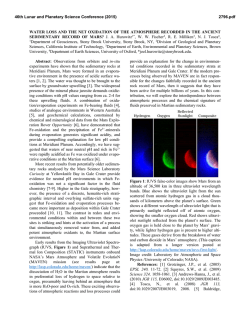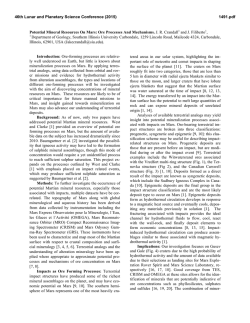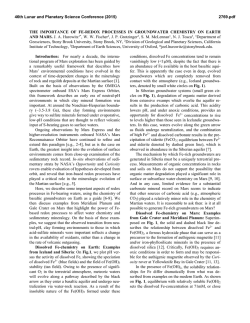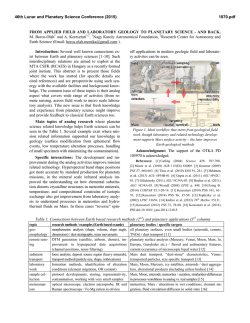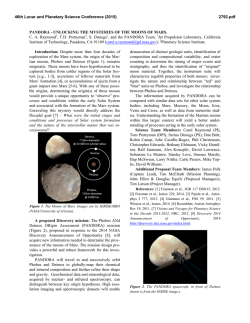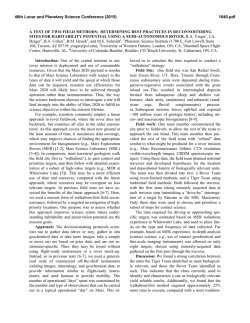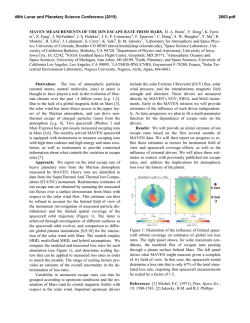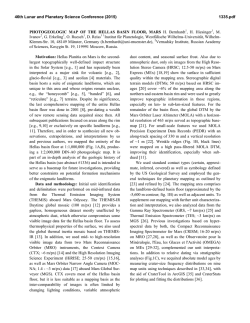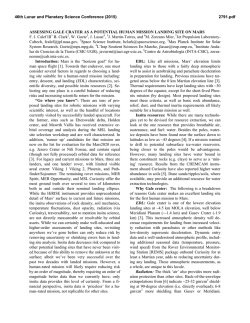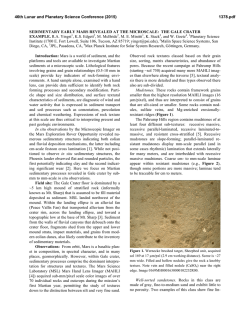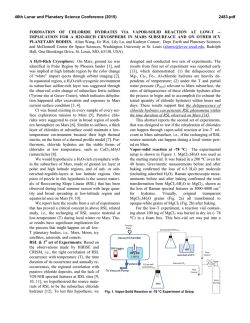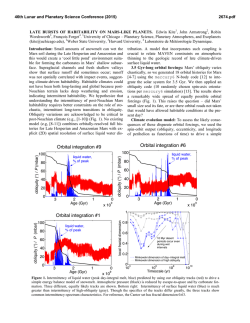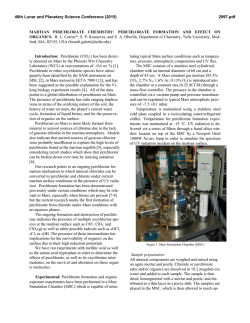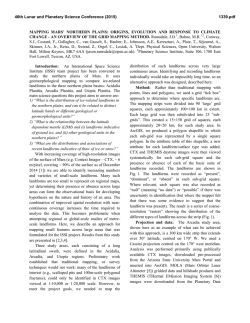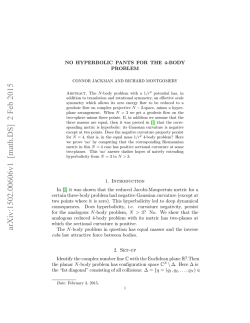
MARS
46th Lunar and Planetary Science Conference (2015) 2276.pdf MARSDROP MICROPROBE ARCHITECTURE: BROADENING THE SCIENCE RETURN AND IN SITU EXPLORATION FROM MARS MISSIONS. R.M.E. Williams1, M. A. Eby2, R. L. Staehle3, and R. Bhartia3. 1 Planetary Science Institute, 1700 E. Fort Lowell, Suite 106, Tucson, AZ 85719-2395, [email protected], 2 Aerospace Corporation, 3Jet Propulsion Laboratory—California Institute of Technology. Introduction: The diversity of scientifically compelling targets on Mars has scarcely been explored in the few landed spacecraft to date. Whether from the destination risks or just from the vast expense of a single Mars lander, the majority of proposed scientific landing sites are eliminated from consideration. To help bridge this shortfall, we propose an architecture to enable low cost delivery of small (~1 kg), useful scientific payloads to designated spots on Mars as secondary payload(s) on Mars-bound spacecraft. The Aerospace Corporation’s and JPL’s experience with very small reentry vehicles (Reentry Breakup Recorder [REBR], and Deep Space 2 [DS2]) forms the starting point for a passively stable entry vehicle, whose low mass/low ballistic coefficient allows for a subsonic deployment of a steerable parawing glider and guided flight for a targeted landing (Fig. 1). In sum, MARSDROP represents a new approach to augment Mars exploration by enabling precisely-targeted science at minimal cost for in situ investigation at scientifically compelling locations [1, 2]. Here, we discuss the scientific merit and capabilities of this approach, details of the MARSDROP architecture and technology demonstrations to date. Science Motivation: The MARSDROP capability enables a new class of Mars science investigations by being able to deliver multiple miniaturized instruments to the most desirable locations for network science, ground truth studies, and enhances the search for biosignatures by increasing the number of sample sites The ability to steer to targets of interest during the gliding phase opens up a wide variety of enticing locations including: a) within the canyons of Valles Marineris, b) lava flows in volcanic regions such as Tharsis, c) water-transported sediment deposits in alluvial fans and deltas9 (such as Eberswalde), d) proposed glaciers [3] and ice-rich terrains, e) the subliming ‘Swiss cheese’ terrain of the southern polar cap [4], f) water carved terrain from catastrophic floods (e.g., circum-Chryse outflow channels), g) polar caps, h) potential geysers that create spider-terrain in high southern latitudes [5], i) bottoms of fresh impact crater sites [6] with high organic preservation potential, j) surface “windows” that serve as skylights opening to subsurface ‘caves’ [7], k) gullies[8, 9], and l) other surface changes, such as recurring slope lineae (RSL) [10] which may be signs of seasonal subsurface water running down crater walls. With multiple MARSDROP capsules on a single mission, there is the potential to create a distributed weather station and/or seismic network. Taking advantage of periodic impact events (several occur annually), the interior structure of Mars can be probed. This seismic data would complement forthcoming data from the InSight mission and the ground penetrating radar instrument (RIMFAX) on the Mars 2020 rover. MARSDROP Architecture: The push for a viable Mars microprobe landing architecture dates back to the attempted, but unsuccessful, DS2 probes deployed from Mars Polar Lander. While leveraging understood technology, the overall approach of delivering miniaturized instruments using a self-guided gliding microprobe is a radical and unexplored departure from existing Mars exploration architectures. MARSDROP enables low cost delivery of small landers (~30 cm diameter probe, carrying a ~1kg scientific payload) to designated spots on Mars [1, 2]. Such deliveries would piggyback on Mars-bound spacecraft, making use of often-available excess launch vehicle and cruise-stage mass capability, analogous to the DS2 probes. The Aerospace Corporation’s successful, very small Earth Reentry Breakup Recorder (REBR) vehicle2 forms the starting point for a low mass/low ballistic coefficient entry system that allows for subsonic deployment of a steerable parawing glider, capable of up to 10 min and 10 + km of guided flight and impact the surface with a 3:1 glide ratio at ~20.5 m/s. An imaging system melded with an autonomous terrain-relative navigation/control system and a tiny Electracompatible radio enable landing within tens of meters of one of several specified targets within a 95% probability 53 x 8 km target ellipse5 and return of megabits of data. The relatively low cost (estimated $20 – 50 M) of each probe, combined with an ability to send multiple, redundant probes enables access to regions of Mars deemed scientifically interesting, but too risky for a large, expensive lander. To study the viability of the concept, The Aerospace Corporation has conducted proof-of-concept tests from high-altitude balloons. At ~100,000 feet (~30 km) we find an ideal laboratory replicating the Martian atmosphere, a cold and thin atmosphere with a density a scant 1% of that at sea level on Earth. The minimal size and weight of the probe, combined with subsonic test speeds, permit the use of standard weather balloons, minimizing test costs. A mock capsule, fitted with the proposed landing architecture, is attached to a weather balloon, which tows the vehicle to 46th Lunar and Planetary Science Conference (2015) a 20 mile (~32 km) altitude. Cutting free from the balloon, the capsule free falls briefly until it matches the speed (~400 mph; ~640 km/hr) and dynamic pressure (~200 Pa) it would see during parawing deployment on Mars. During backshell deployment, inflation loads are measured with a 100-g accelerometer, while GPS readings track the probe’s forward and vertical velocity during its descent. These tests showed that the parawing constructed could withstand deployment dynamic pressure without damage, and the landing system fits within the capsule, leaving sufficient volume and mass for a useful landed payload. The team has begun exploring plausible payload instruments that fit within the capsule (30 cm diameter, ~1 kg payload). Small, lightweight radios, scientific instruments from seismometers to a lab-on-a-chip, cameras, and higher-energy-density batteries all advance the utility of the landed mass far beyond DS2 capability. The breadth of viable instrumentation ranged from high resolution science-grade and mineralogy cameras, to simple weather instrumentation, to environmental sensors for near-surface atmosphere characterization, to focused derivatives of organicssearch instrumentation. For example, the team is considering a miniaturized version of the deep UV fluorescence SHERLOC instrument that was recently selected for the Mars2020 lander and is capable of characterizing trace organics and astrobiologically relevant minerals on unprepared rock surfaces [11]. Many of these 2276.pdf instruments are considered feasible in the near-term to meet the space constraints and tolerate the rigors of space flight and landing. Summary: The MARSDROP architecture can double or triple the number of Mars landers at small additional cost for each mission opportunity. With a guided flight capability, the payload can be delivered to regions previously considered high-risk. In addition, this targeted delivery enables distributed network science applications and could provide reconnaissance data for future missions. In short, this delivery system can dramatically enhance the scientific return of Mars exploration, providing access to sites of high geologic and astrobiologic interest. References: [1]Staehle, R. L. et al. (2014) 65th International Astronautical Congress, http://www.iafastro.net/iac/paper/id/22457/summary/ [2] Staehle, R. L. et al. (2014) Mars CubeSat Workshop. [3] Garvin, J. B et al., 2006, Meteoritics & Planetary Science, 41. 1659-1674.. [4] Malin, M. C., et al., Science 294, 2146-2148. [5] Kieffer, H. H., et al., 2006, Nature 442, 793-796. [6] Malin, M. C., et al., 2006, Science 314, 1573-1577. [7]Cushing, G. E., 2007, LPSC #1371., [8] Dundas et al., 2010 GRL. [9] Malin, M. C. and K. S. Edgett, 2000, Science, 288, 2330-2335. [10] McEwen et al., 2011, Science, 333, 740-743. [11] Beegle, L. W. et al., (2014) LPSC. Abstract #2835. Figure 1: A) MARSDROP microprobe landing architecture. B) MarsDrop balloon test descending to Nevada desert floor superimposed on MER scene. Image “color matched” to Mars. C) Engineering team holding parawing with balloon test article on table.
© Copyright 2026
